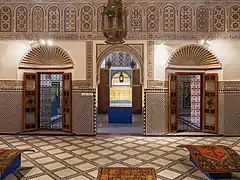Dar Si Said
Dar Si Said (Arabic: دار السي سعيد) is a historic late 19th-century palace and present-day museum in Marrakesh, Morocco.
.jpg.webp)
History
It was built between 1894 and 1900 by Si Sa'id ibn Musa, a vizier and minister of defence under his brother Ba Ahmad ibn Musa, who was the Grand Vizier and effective ruler of Morocco during the same period under Sultan Abdelaziz (ruled 1894–1908).[1][2][3] After 1914, under the French Protectorate administration, the palace served as the seat of the regional leaders of Marrakesh.[3] It was converted into a museum of "indigenous arts" (meaning Moroccan art) and woodcraft in 1930 or 1932.[4][5][6] In 1957, after Moroccan independence, the palace was split into a museum section and a section occupied by the Service de l’Artisanat (Agency of Artisanship).[4][5] It has been restored several times since and remains a museum today.[6] Following the most recent renovations, carried out by the recently-created[7] Fondation Nationale des Musées, the museum reopened in 2018 as the National Museum of Weaving and Carpets.[8][9]
Architecture
The palace's architecture is similar in ornament to the Bahia Palace built further south by his father and his brother, but unlike the latter it is built over more than one level and has a very different layout. Its architectural highlights include a grand reception hall on the upper floor and a large riad garden with a central pavilion of painted wood.[9][2][1]
Museum collection
The museum collections includes a wide variety of objects, many of them from the southern regions of Morocco.[10] Until recently the museum's exhibits focused on Moroccan wooden art and objects.[10] Following its reopening in 2018, its current exhibits now focus on weaving and Moroccan carpets.[9][8]
Andalusian marble basin
Among the most significant objects of the general collection is an elaborately carved marble basin from the Caliphate era of Cordoba. It was crafted at Madinat al-Zahra between 1002 and 1007 to serve as ablutions basin and was dedicated to 'Abd al-Malik, the son of al-Mansur, and was one of a series. It was previously kept at the Ben Youssef Madrasa for centuries and was first noted by experts in 1923.[11][12][13] Scholar Mariam Rosser-Owen has suggested that the basin was originally imported to Marrakesh by Ali Ibn Yusuf, who incorporated a number of marble spolia from the ruined palaces of Cordoba in the Ben Youssef Mosque that he built in the 12th century. The basin would have then been re-used again for the Ben Youssef Madrasa, which was built in the same area much later, after the mosque had fallen into neglect.[14]
Gallery
 The riad garden
The riad garden.jpg.webp) Painted decoration inside the wooden pavilion of the garden
Painted decoration inside the wooden pavilion of the garden A courtyard with fountain in the palace
A courtyard with fountain in the palace One of the grand halls in the palace
One of the grand halls in the palace Cupola over the grand hall
Cupola over the grand hall Rooms of the palace with exhibit on Moroccan carpets
Rooms of the palace with exhibit on Moroccan carpets
See also
- Marrakech Museum
- Bahia Palace
- Nejjarine Museum (in Fes)
References
| Wikimedia Commons has media related to Dar Si Said Museum. |
- Wilbaux, Quentin (2001). La médina de Marrakech: Formation des espaces urbains d'une ancienne capitale du Maroc. Paris: L'Harmattan. p. 289. ISBN 2747523888.
- Deverdun, Gaston (1959). Marrakech: Des origines à 1912. Rabat: Éditions Techniques Nord-Africaines. p. 546.
- "Le Musée Dar Si Saïd | Visiter-Marrakech.com" (in French). 2014-05-23. Retrieved 2021-01-24.
- "Musée Dar si Saïd de Marrakech". Fondation nationale des musées (in French). Retrieved 2021-01-24.
- "Le Musée Dar Si Saïd | Visiter-Marrakech.com" (in French). 2014-05-23. Retrieved 2021-01-24.
- Marrakech, Travelguide (2018-01-12). "The Museum Dar Si Said". Travelguide Marrakech. Retrieved 2020-06-04.
- "Fondation nationale des MuséesMehdi Qotbi veut se mettre vite au travail". L'Economiste (in French). 2011-12-21. Retrieved 2021-01-24.
- "Ouverture du Musée National du Tissage et du Tapis Dar Si Saïd de Marrakech" (in French). Retrieved 2021-01-24.
- "Dar Si Said | Marrakesh, Morocco Attractions". Lonely Planet. Retrieved 2020-06-04.
- "Dar Si Said (Marrakech, Morocco)". Discover Islamic Art - Virtual Museum. Retrieved 2020-06-05.
- Dodds, Jerrilynn D., ed. (1992). "255". Al-Andalus: The Art of Islamic Spain. New York: The Metropolitan Museum of Art. ISBN 0870996371.
- El Khatib-Boujibar, Naima. "Ablutions basin". Discover Islamic Art, Museum With No Frontiers. Retrieved June 5, 2020.
- Discover Islamic Art in the Mediterranean. Arab Institute for Research and Publishing. 2007. p. 86.
- Rosser-Owen, Mariam (2014). "Andalusi Spolia in Medieval Morocco: "Architectural Politics, Political Architecture"". Medieval Encounters. 20 (2): 152–198.
